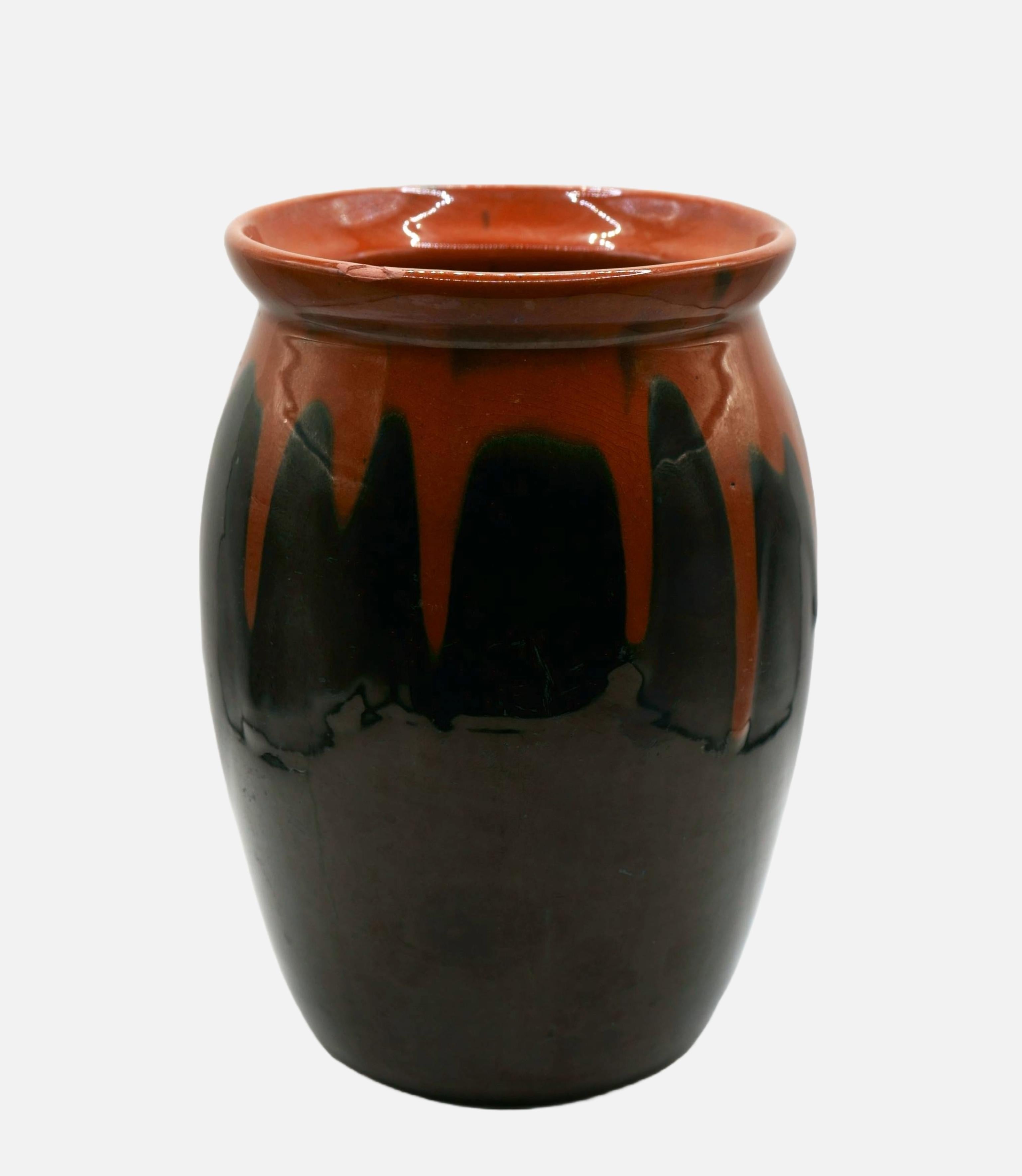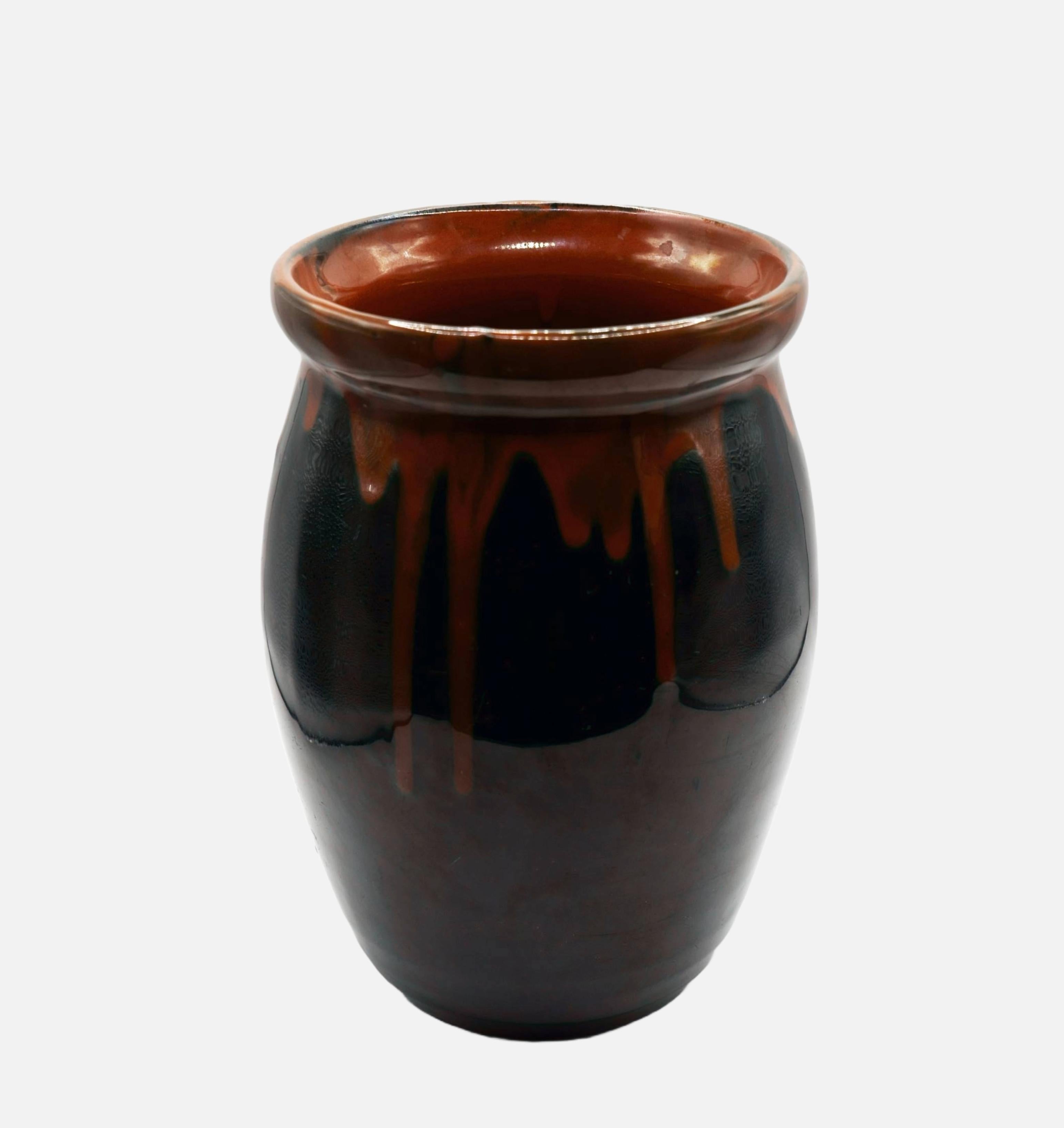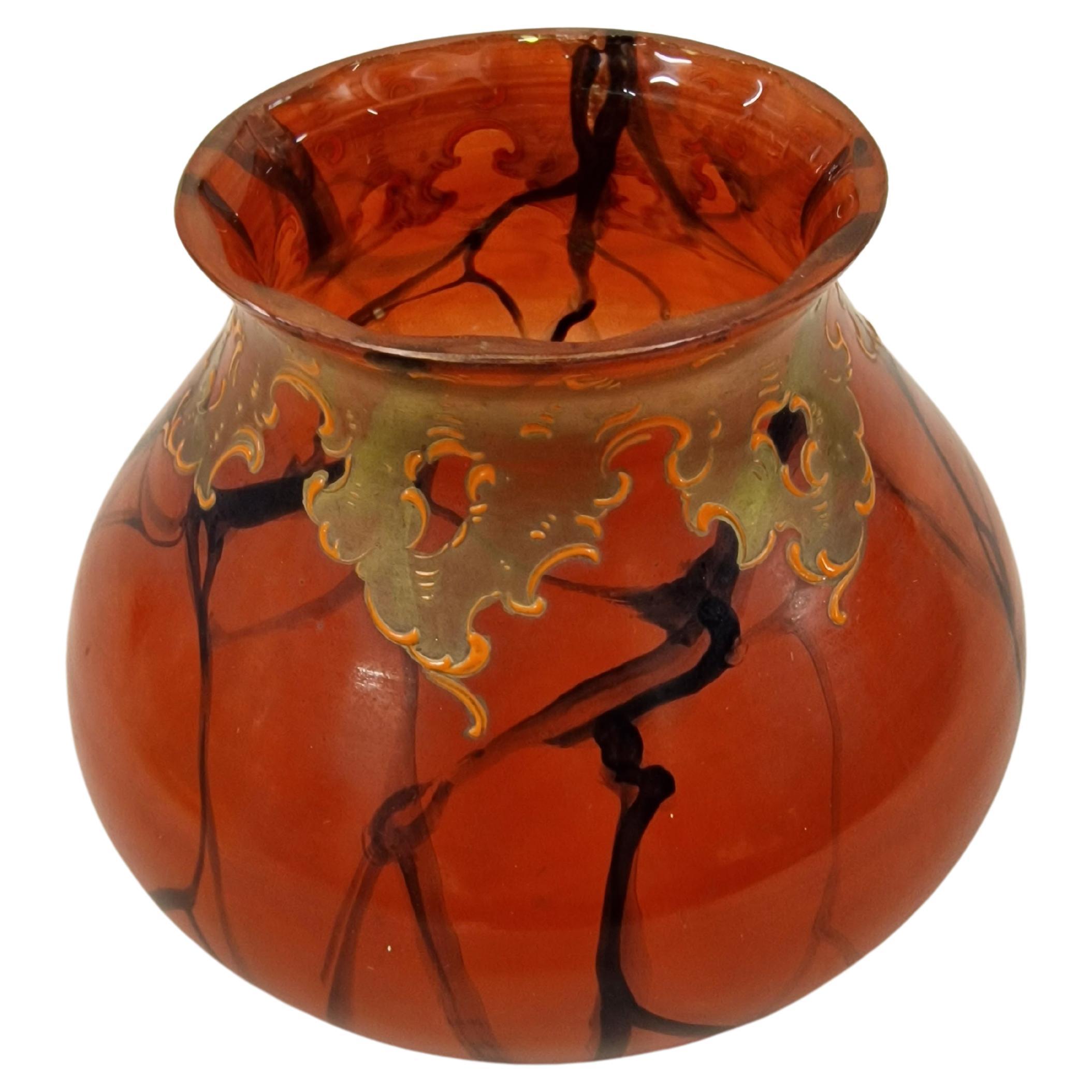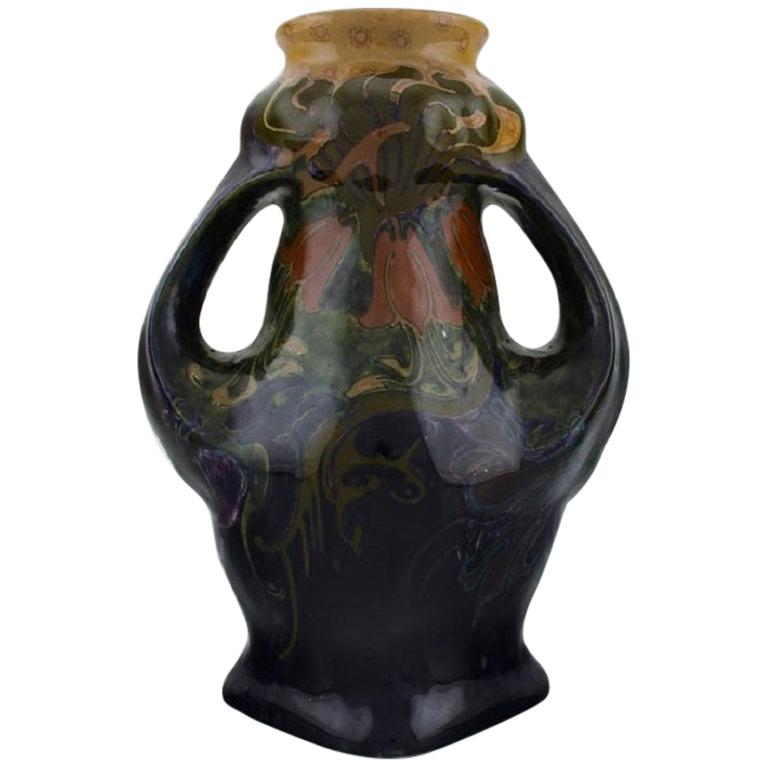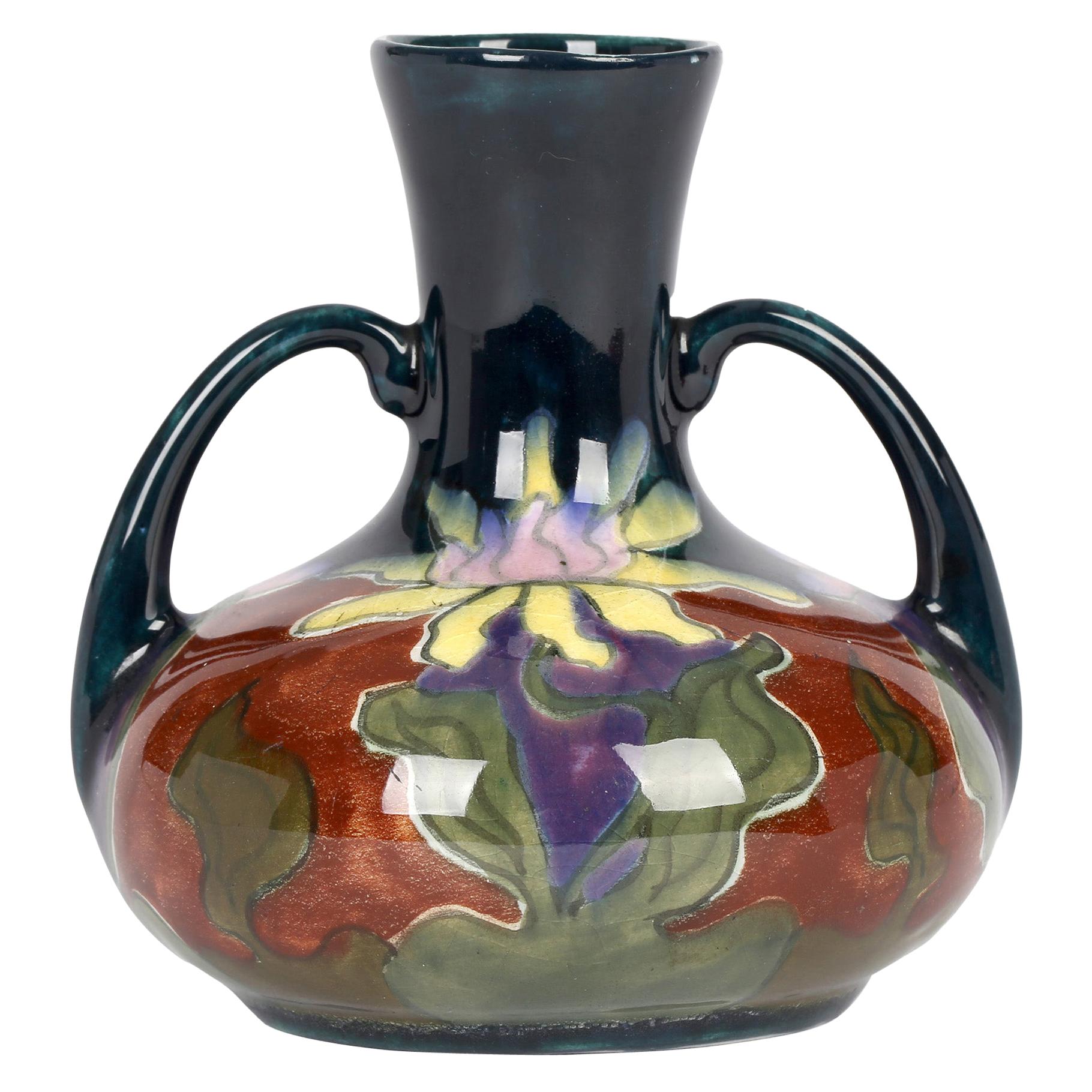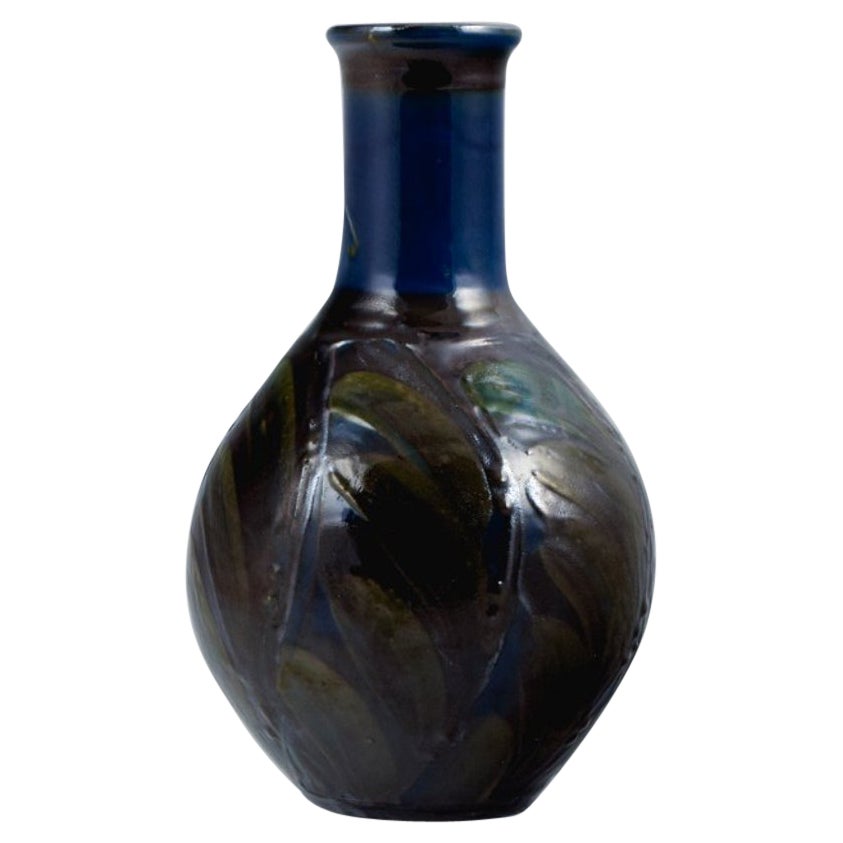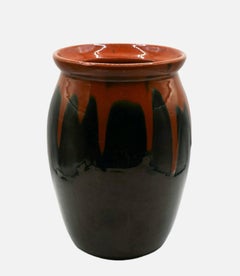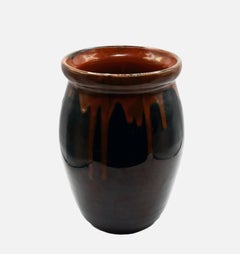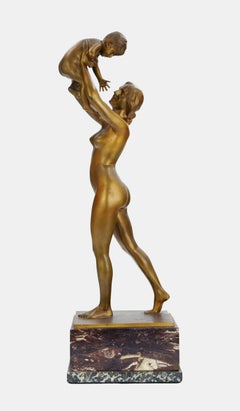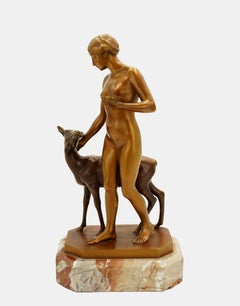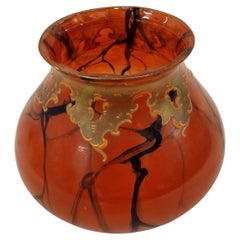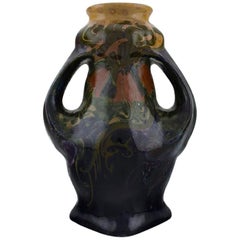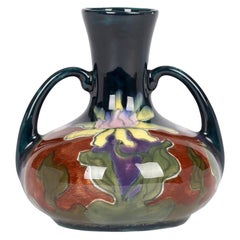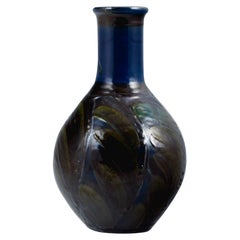Items Similar to Kunsttöpferei Kandern, Thrown vase with double gradient glaze / - Flowering vase
Want more images or videos?
Request additional images or videos from the seller
1 of 5
Kunsttöpferei Kandern, Thrown vase with double gradient glaze / - Flowering vasec. 1920
c. 1920
$169.20
$211.5020% Off
£129.57
£161.9620% Off
€144
€18020% Off
CA$237.81
CA$297.2620% Off
A$260.87
A$326.0820% Off
CHF 136.49
CHF 170.6120% Off
MX$3,104.82
MX$3,881.0320% Off
NOK 1,723.94
NOK 2,154.9220% Off
SEK 1,617.09
SEK 2,021.3620% Off
DKK 1,096.98
DKK 1,371.2320% Off
About the Item
Kunsttöpferei Kandern (1897-1927), Thrown vase with two layers of glaze, between 1914 and 1927, terracotta, marked 'KTK' on the underside and marked as model number '781', 19 cm (height) x 13 cm (diameter), interior size of the opening: 6 cm.
- two small glaze chips at the mouth, minimal bumps, otherwise in very good condition
- Flowering vase -
The squat, bulbous shape of the vase is designed to be viewed from above. When viewed from above, the double gradient glaze - a creamy white on a blue-black background - looks like a flower. The floral effect, made all the more striking by the abstract design language, is enhanced by the fact that the body has been left clay-colored to resemble a flower pot. The overglaze does not protrude clearly from the body, so that the overall effect is that of a flower. In this respect, the vase already contains a flower, even if it remains unused.
About the Kunsttöpferei Kandern
After Max Laeuger had been working intensively on ceramic design in Kandern and Karlsruhe since 1892, he founded the Prof. Laeuger'sche Kunsttöpferei as part of the Tonwerke Kandern in 1897. Under his direction, which lasted until 1913, he created 738 designs for vessels and 320 designs for architectural ceramics. The works are marked with the pressed mark of the letters "MLK" set in a square.
Laeuger introduced new artistic techniques to pottery. In addition to the effective gradient glaze, in particular slip painting, which is based on the pâte sur pâte technique of porcelain design, in which colored clay is painted onto the clay body. This creates relief-like effects and allows the creation of entirely new patterns. Using these techniques, Laeuger transferred the ornamentation of Art Nouveau to ceramics in an innovative, abstract, and materially oriented way, thus establishing modern artistic ceramics. These innovations were by no means limited to the supposedly artistically irrelevant field of handicrafts. On the contrary, a new, socially reforming artistic aspiration emanated from the arts and crafts, which is also reflected in Laeuger's co-founding of the Deutscher Werkbund in 1907.
After leaving Kandern, Laeuger established his own ceramics workshop in Karlsruhe in 1916, where he produced some 5,000 ceramics until 1944 and supplied the Staatliche Majolika Manufaktur Karlsruhe, founded on the initiative of Hans Thoma and Wilhelm Süs, with designs between 1921 and 1929.
In 1920, Hermann Hakenjos Sr. took over the Kandern art pottery, which continued in the artistic spirit of Laeuger and whose products were marked with the incised letters "KTK" in a square. In 1927, Hakenjos and the ceramist Richard Bampi founded the Fayence-Manufactur Kandern. Their products were stamped with the letters "FMK" in a triangle.
GERMAN VERSION
Kunsttöpferei Kandern (1897-1927), Gedrungene Vase mit zweifacher Verlaufsglasur, zwischen 1914 und 1927. Terrakotta, auf dem Unterboden mit ‚KTK‘ gemarkt und als Modell Nummer ‚781‘ ausgewiesen, 10 cm (Höhe) x 13 cm (Durchmesser), Innenmaß der Öffnung: 6 cm.
- zwei kleine Glasurabplatzungen an der Mündung, minimale bestoßene Stellen, ansonsten in sehr gutem Zustand
- Blühende Vase -
Die gedrungene bauchige Vasenform ist für die Aufsicht konzipiert. Von oben betrachtet, wirkt die zweifache Verlaufsglasur – ein cremefarbenes Weiß auf blauschwarzem Grund – wie eine Blüte. Der durch die abstrakte Formensprache umso eindringlichere florale Effekt wird zusätzlich verstärkt, indem der Korpus tonfarben belassen wurde und damit an einen Blumentopf gemahnt. Auch läuft die Überfangglasur nirgends deutlich über die Bauung hinaus, so dass sie insgesamt als Blüte gewahrt wird. In dieser Hinsicht steckt in der Vase bereits eine Blume, auch wenn sie unbenutzt bleibt.
zur Kunsttöpferei Kandern
Nachdem sich Max Laeuger bereits seit 1892 intensiv in Kandern und Karlsruhe mit der Gestaltung von Keramik beschäftigt hatte, gründete er 1897 die Prof. Laeuger'sche Kunsttöpferei als Teil der Tonwerke Kandern. Unter seiner bis 1913 währenden Leitung entstanden 738 Muster für Gefäße und 320 baukeramische Vorlagen. Die ausgeführten Werke sind mit der Pressmarke der in ein Quadrat gefassten Buchstaben ‚MLK‘ versehen.
Laeuger führte neue künstlerische Techniken in die Töpferei ein. Neben der effektvollen Verlaufsglasur insbesondere die an der Pâte sur Pâte-Technik der Porzellangestaltung orientierte Schlickermalerei, bei der mit eingefärbter Tonmasse auf den Tonkorpus gemalt wird. Dies führt zu reliefartigen Effekten und ermöglicht die Kreation ganz neuer Muster. Vermittels dieser Techniken hat Laeuger die Ornamentik des Jugendstils auf eine am Material orientierte innovativ abstrahierende Weise in die Töpferei überführt und damit die moderne Künstlerkeramik begründet. Diese Neuerungen waren keineswegs auf das vermeintlich künstlerisch irrelevante Gebiet des Kunstgewerbes beschränkt. Vielmehr ging gerade vom Kunsthandwerk ein neuer gesellschaftsreformatorischer künstlerischer Anspruch aus, der sich auch darin niederschlägt, dass Laeuger 1907 den Deutschen Werkbund mitbegründete.
Nach seinem Weggang aus Kandern richtete sich Laeuger 1916 in Karlsruhe eine eigene Keramikwerkstatt ein, wo er bis 1944 etwa 5000 Keramiken schuf und zwischen 1921 und 1929 die auf Initiative von Hans Thoma und Wilhelm Süs gegründete Staatliche Majolika Manufaktur Karlsruhe mit Entwürfen belieferte.
In Kandern übernahm Hermann Hakenjos sen. ab 1920 die im künstlerischen Geiste Laeugers weiterführte Kunsttöpferei, deren Produkte mit den geritzten, in ein Quadrat eingeschriebenen Buchstaben ‚KTK‘ gemarkt wurden. 1927 gründete Hakenjos zusammen mit dem Keramiker Richard Bampi die Fayence-Manufactur Kandern. Ihre Erzeugnisse tragen die Stempelmarke der in ein Dreieck eingelassenen Buchstaben ‚FMK‘.
- Creation Year:c. 1920
- Dimensions:Height: 3.94 in (10 cm)Width: 5.12 in (13 cm)
- Medium:
- Movement & Style:
- Circle Of:Max Laeuger (1864 - 1952, German)
- Period:
- Condition:
- Gallery Location:Berlin, DE
- Reference Number:1stDibs: LU2438215022942

About the Seller
5.0
Vetted Professional Seller
Every seller passes strict standards for authenticity and reliability
Established in 2014
1stDibs seller since 2023
22 sales on 1stDibs
- ShippingRetrieving quote...Shipping from: Berlin, Germany
- Return Policy
More From This Seller
View AllKunsttöpferei Kandern, Bulbous vase with gradient glaze / - Inner abundance -
Located in Berlin, DE
Kunsttöpferei Kandern (1897-1927), Bulbous vase with clay-colored gradient glaze on a black-blue ground, between 1914 and 1927. Terracotta, marked 'KTK' on the underside and identifi...
Category
1920s Art Nouveau More Art
Materials
Terracotta
$263 Sale Price
20% Off
Kunsttöpferei Kandern, Bulbous vase with gradient glaze / - Inner abundance -
Located in Berlin, DE
Kunsttöpferei Kandern (1897-1927), Bulbous vase with clay-colored gradient glaze on a black-blue ground, between 1914 and 1927. Terracotta, marked 'KTK' on the underside and identifi...
Category
1920s Art Nouveau More Art
Materials
Terracotta
$272 Sale Price
20% Off
Mother Happiness / - The ecstasy of maternal joy -
Located in Berlin, DE
Johannes Boese (1856 Ostrog - 1917 Berlin), Mutterglück, um 1910. Goldbraun patinierte Bronze auf gegossener rechteckiger Plinthe, montiert auf zweifarbigem Marmorsockel (9,5 cm Höhe...
Category
1910s Art Nouveau Nude Sculptures
Materials
Bronze
$3,948 Sale Price
20% Off
Forest idyll / - Soulmate -
By Rudolf Kaesbach
Located in Berlin, DE
Rudolf Kaesbach (1873 Gladbach - 1955 Berlin), Forest idyll, around 1915. Bronze, gold and golden brown patina, with cast plinth, mounted on a marble base (5 cm high), total height 36 cm, dimensions of the bronze: 31 cm (height) x 17 cm (length) x 12 cm (width). Weight 4,6 kg, signed on the plinth "R.[udolf] KAESBACH".
- a few rubbed areas, overall in excellent condition for its age
- Soulmate -
The bronze sculpture depicts a young woman in an intimate exchange with a deer that accompanies her. The animal pauses to turn toward her, while the nude beauty slows her pace to look into the deer's eyes and tenderly caress it with her hand. The woman and the deer are in inner harmony. Even though her lips remain motionless, she speaks the language of the animal with which she is deeply connected.
The golden patina, which contrasts with the more naturalistic coloring of the deer, gives the young woman the appearance of a saint, even if she cannot be identified as such. At the same time, she evokes memories of Diana, the goddess of the hunt, or a nymph. But she lacks the ferocity. In her innocent naivety, she is more like a vestal virgin, who is not at home in the solitude of the forest. And yet, the young beauty, moving unclothed in the heart of nature, looks like a priestess with her hair tied up and a carefully carried bowl on her way to a sacred grove.
In order to open up the above-mentioned associations, Kaesbach deliberately designed the female figure in such a way that she cannot be identified as a specific person. He has created an allegory of natural femininity, characteristic of Art Nouveau, in which the deer is far more than a companion animal. It displays the same gracefulness as the young woman, and the inner resemblance between the two makes the deer appear as her other self. In animal terms, it embodies her inner being, which also gives the deer an allegorical character.
About the artist
Rudolf Kaesbach studied sculpture at the Hanau Academy and worked in a bronze foundry in Paris in 1900. In order to work as an independent artist, he opened a workshop in Düsseldorf, where he cast bronzes from models he designed. In 1902 he made his debut at the German National Art Exhibition in Düsseldorf. The following year Kaesbach went to the academy in Brussels. There he was inspired by contemporary Belgian sculpture, especially the work of Constantin Meunier. He moved to Berlin, where he opened a studio in the villa district of Grunewald and devoted himself to life-size marble sculptures and the design of bronzes. From 1911, he regularly presented his works at the major art exhibitions in Berlin, as well as in Düsseldorf and Malmö. Between 1936 and 1939, he also created models for the Rosenthal porcelain factory. From 1939 to 1944, Kaesbach was represented at the major German art exhibitions in Munich.
GERMAN VERSION
Rudolf Kaesbach (1873 Gladbach - 1955 Berlin), Waldidyll, um 1915. Gold und goldbraun patinierte Bronze mit gegossener Plinthe, auf einem Marmorsockel montiert (5 cm Höhe), Gesamthöhe 36 cm, Maße der Bronze: 31 cm (Höhe) x 17 cm (Länge) x 12 cm (Breite). Gewicht 4,6 kg, auf der Plinthe mit „R.[udolf] KAESBACH“ signiert.
- vereinzele beriebene Stellen, insgesamt in einem altersgemäß ausgezeichneten Zustand
- Seelenverwandtschaft -
Die Bronzeplastik veranschaulicht eine junge Frau im innigen Austausch mit einem sie begleitenden Reh. Das Tier hält inne, um sich zu ihr hochzuwenden, während die nackte Schönheit ihren Schritt verlangsamt, um dem Reh ebenfalls in die Augen zu schauen und es zärtlich mit der Hand zu liebkosen. Die Frau und das Reh sind in einem inneren Gleichklang. Auch wenn ihre Lippen unbewegt bleiben, spricht sie die Sprache des Tieres, mit dem sie auf eine tief empfundene Weise verbunden ist.
Die im Kontrast zur naturalistischeren Einfärbung des Rehs aufstrahlende goldfarbene Patina lässt die junge Frau wie eine Heilige erscheinen, auch wenn sich nicht als Heilige identifizierbar ist. Zugleich ruft sie Erinnerungen an die Jagdgöttin Diana oder eine Nymphe hervor. Dafür fehlt ihr allerdings die Wildheit. In ihrer unschuldigen Naivität gemahnt sie vielmehr an eine Vestalin, die freilich nicht in der Waldeinsamkeit zu Hause ist. Und doch wirkt die sich unbekleidet im Herzen der Natur bewegende junge Schönheit wie eine Priesterin, die sich mit hochgebundenem Haar und der vorsichtig getragenen Schale und dem Wege zu einem Heiligen Hain befindet.
Um die gennannten Assoziationen zu eröffnen, hat Kaesbach die Frauenfigur bewusst so gestaltet, dass sie nicht als konkrete Person identifizierbar ist. Damit hat er eine für den Jugendstil charakteristische Allegorie natürlicher Weiblichkeit geschaffen, bei der das Reh weit mehr als ein Begleittier ist. Es weist dieselbe grazile Anmut wie die junge Frau auf und der innere Gleichklag der beiden lässt das Reh als ihr anderen Ich erscheinen. Es verkörpert – ins Animalische übertragen - ihr inneres Wesen, wodurch auch dem Reh ein allegorischer Charakter zukommt.
zum Künstler
Rudolf Kaesbach studierte an der Akademie Hanau Bildhauerei und war im Jahr 1900 in einer Pariser Bronzegießerei tätig. Um sich als eigenständiger Künstler betätigen zu können, eröffnete er in Düsseldorf eine Werkstatt, in der er Bronzen nach selbstentworfenen Modellen goss. 1902 debütierte er auf der Deutschen Nationalen Kunstaustellung in Düsseldorf. Im Folgejahr ging Kaesbach an die Akademie nach Brüssel. Dort wurde er von der zeitgenössischen belgischen Bildhauerei, insbesondere vom Werk Constantin Meuniers, inspiriert. Zurückgekehrt zog er nach Berlin, wo er im Villenviertel Grunewald ein Atelier eröffnete und sich neben dem Entwurf für Bronzen der lebensgroßen Marmorbildhauerei widmete. Ab 1911 präsentierte er seine Werke regelmäßig auf den Großen Berliner Kunstausstellungen, aber auch in Düsseldorf und Malmö. Zwischen 1936 und 1939 fertigte er zudem Modelle für die Porzellan-Manufaktur Rosenthal an. Von 1939 bis 1944 war...
Category
1910s Jugendstil Nude Sculptures
Materials
Bronze
$3,948 Sale Price
20% Off
The Feeding / - Natural grace -
Located in Berlin, DE
Erich Schmidt-Kestner (1877 Berlin - 1941 Nordhausen), The Feeding, around 1915. Gold and black patinated bronze with cast brown patinated plinth mounted on a lightly veined black-gr...
Category
1910s Art Nouveau Nude Sculptures
Materials
Bronze
$4,230 Sale Price
20% Off
Vegetative Form / - Grown Art -
Located in Berlin, DE
Paul Dierkes (1907 Cloppenburg - 1968 Berlin), Vegetative Form. Mahogany, 1958. 142 x 16 x 10 cm (sculpture), 21 x 17.5 cm (base), monogrammed "PD" on the reverse.
- Grown Art -
...
Category
1950s Post-War Abstract Sculptures
Materials
Mahogany
$3,290 Sale Price
20% Off
You May Also Like
Flower Vase, Hand Painted, 1910 Art Nouveau / Jugendstil, France
Located in Wien, AT
This french Vase is a very nice, early object of the Art Nouveau / Jugendstil era.
The glass body is made of orange glass with a beautifully cut top. The entire bolbous body is ove...
Category
Antique Early 1900s French Art Nouveau Vases
Materials
Glass
$640 Sale Price
20% Off
Rozenburg, Den Haag, Large Art Nouveau Vase in Glazed Ceramics, 1910s-1920s
Located in København, Copenhagen
Rozenburg, Den Haag. Large Art Nouveau vase with handles in glazed ceramics with flowers, 1910s-1920s.
Measures: 27 x 21 cm.
Stamped.
In very good condition.
Category
Vintage 1910s Dutch Art Nouveau Vases
Materials
Ceramic
$1,120 Sale Price
30% Off
Old Moravian Austrian Art Nouveau Floral Painted Twin Handled Vase
Located in Bishop's Stortford, Hertfordshire
A stylish Austrian Art Nouveau twin handled art pottery vase hand painted with floral designs and made at Old Moravian Pottery around 1906. The squat ...
Category
Antique Early 1900s Austrian Art Nouveau Vases
Materials
Pottery
Kähler, Large Ceramic Vase with Floral Decoration in Cow Horn Technique, 1930s
Located in København, Copenhagen
Kähler, large ceramic vase with floral decoration in cow horn technique.
1930s.
Marked.
Perfect condition.
Dimensions: H 30.0 x D 16.5 cm.
Category
Vintage 1930s Danish Vases
Materials
Ceramic
$504 Sale Price
30% Off
Karl Hansen Reistrup for Kähler, Antique Vase in Glazed Ceramics, 1890s
Located in København, Copenhagen
Karl Hansen Reistrup for Kähler. Antique vase in glazed ceramics. Beautiful luster glaze, 1890s.
Measures: 21 x 9.5 cm.
In excellent condition.
Signed: HAK.
Category
Antique 1890s Danish Art Nouveau Vases
Materials
Ceramic
$532 Sale Price
30% Off
Art Nouveau ceramic vase from Schramberg. 1900 - 1920
Located in CADALSO, ES
Great condition
Category
Early 20th Century German Art Nouveau Vases
Materials
Ceramic
More Ways To Browse
Von Hans
Colored Clay
Clay Flower
Pate Sur Pate Porcelain
Clay Relief
Richard Bampi
Helen Lewis
Helmut Newton Poster
Jan Michael Vincent
Jan Schaeffer
Janet Cooling
Japanese Propaganda
Je Te Mangerais Dans La Main
Jean Basquiat Plates
Jean Lurcat Plate
Jean Michel Basquiat Bear
Jean Michel Basquiat Sweatshirt
Jeffries Glass
